Fix: Windows Update Failure KB4019472
Microsoft released a new update as part of the May 2017 patch which targeted all machines running on Windows operating system including the original RTM build that is getting the latest improvements. This new update targeted improvements and fixes such as language packs, security updates etc.
However, many users started reporting almost immediately that this update failed to install on their computers and they were unable to use the Windows Update further. Many computers crashed while others had problems such as unable to edit some registry values or increased latency or bandwidth. We have put together a list of solutions to fix this issue.
Solution 1: Running Windows Update Troubleshooter
Microsoft has developed an application named as Windows Update Troubleshooter. It analyzes your system particularly the windows update module and troubleshoots problems. Make sure that the troubleshooting process complete. This application checks and scans all your system files so some time might be consumed.
- Download the Windows Update Troubleshooter from the official Microsoft website.
- Go to the folder where you downloaded it and open the file.
- Once the troubleshooting has started, select the option of Windows Update and click Next.
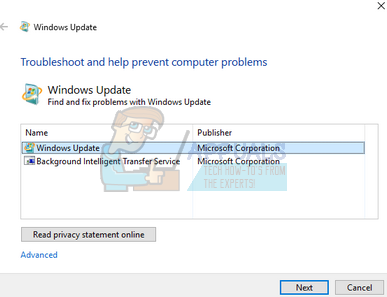
- After you click Next, Windows will start analyzing your machine. All your system files would be scanned along with your registry values. This might consume some time so be patient.

- If there is a newer version of the troubleshooter available, Windows will prompt that a newer edition would be more suitable for the troubleshooting. Click on the option of “Run the Windows 10 Windows Update Troubleshooter” if you are prompted.
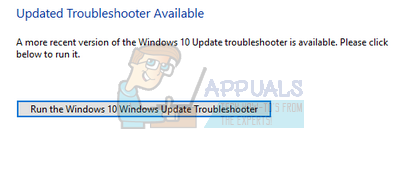
- Click on Next if the following screen appears.
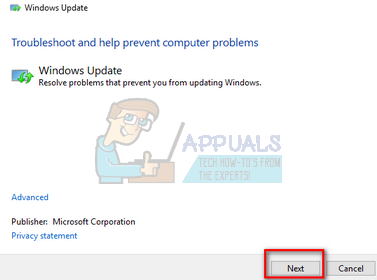
- After the troubleshooter has analyzed your computer and registry values, it might prompt that either there are windows updates pending, the solution was fixed or the solution was not fixed. If you are prompted with a fix, click on “Apply this Fix”.
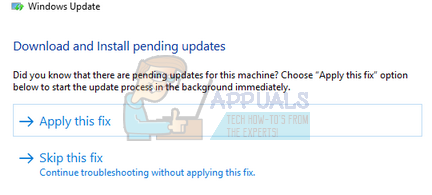
- Now Windows will apply the fix and inform you upon completion. Restart your computer for the changes to take place and check if the error message goes away.
You can also run the Windows Update Troubleshooter from your computer.
- Press Windows + S to launch the start menu’s search bar. Type “troubleshoot” in the dialogue box and click on the first result which comes forth.

- Once in the troubleshoot menu, select “Windows Update” and click the button “Run the troubleshooter”.
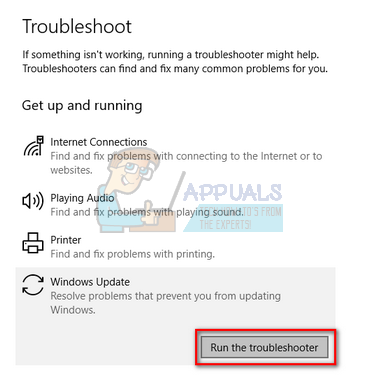
- You might be prompted that the troubleshooter requires administrator access to check for problems with your system. Click the option “Try troubleshooting as an administrator”.
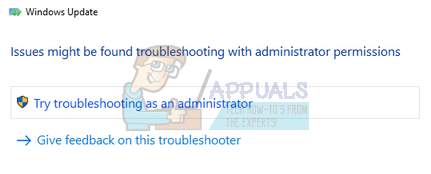
- After the fixes are implemented, restart your computer and check if the problem got fixed.
Note: This solution requires an active internet-connected for optimum results. Also, try to run the troubleshooter a number of times instead of trying only once.
Solution 2: Running System File Checker
System File Checker (SFC) is a utility present in Microsoft Windows which allows the users to scan their computers for corrupt files in their operating system. This tool has been there in Microsoft Windows since Windows 98. It is a very useful tool for diagnosing the problem and checking if any problem is due to corrupt files in windows.
We can try running SFC and see if your problem gets solved. You will get one of the three responses when running SFC.
- Windows didn’t find any integrity violations
- Windows Resource Protection found corrupt files and repaired them
- Windows Resource Protection found corrupt files but was unable to fix some (or all) of them
- Press Windows + R to launch the Run application. Type “taskmgr” in the dialogue box and hit Enter to launch your computer’s task manager.
- Now click on File option present at the top left side of the window and select “Run new task” from the list of options available.
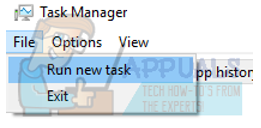
- Now type “powershell” in the dialogue box and check the option underneath which states “Create this task with administrative privileges”.
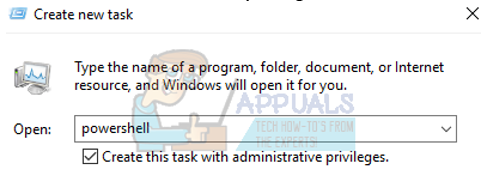
- Once in the Windows Powershell, type “sfc /scannow” and hit Enter. This process may take some time as your entire Windows files are being scanned by the computer and being checked for corrupt phases.

- If you encounter an error where Windows states that it found some error but was unable to fix them, you should type “DISM /Online /Cleanup-Image /RestoreHealth” in the PowerShell. This will download the corrupt files from the Windows update servers and replace the corrupt ones. Do note that this process can also consume some time according to your internet connection. Don’t cancel at any stage and let it run.
If an error was detected and was fixed using the above methods, restart your computer and check if the taskbar started working normally. Perform a Clean Install of Windows after downloading the latest ISO from Microsoft’s website and that should get you up to date with Windows.